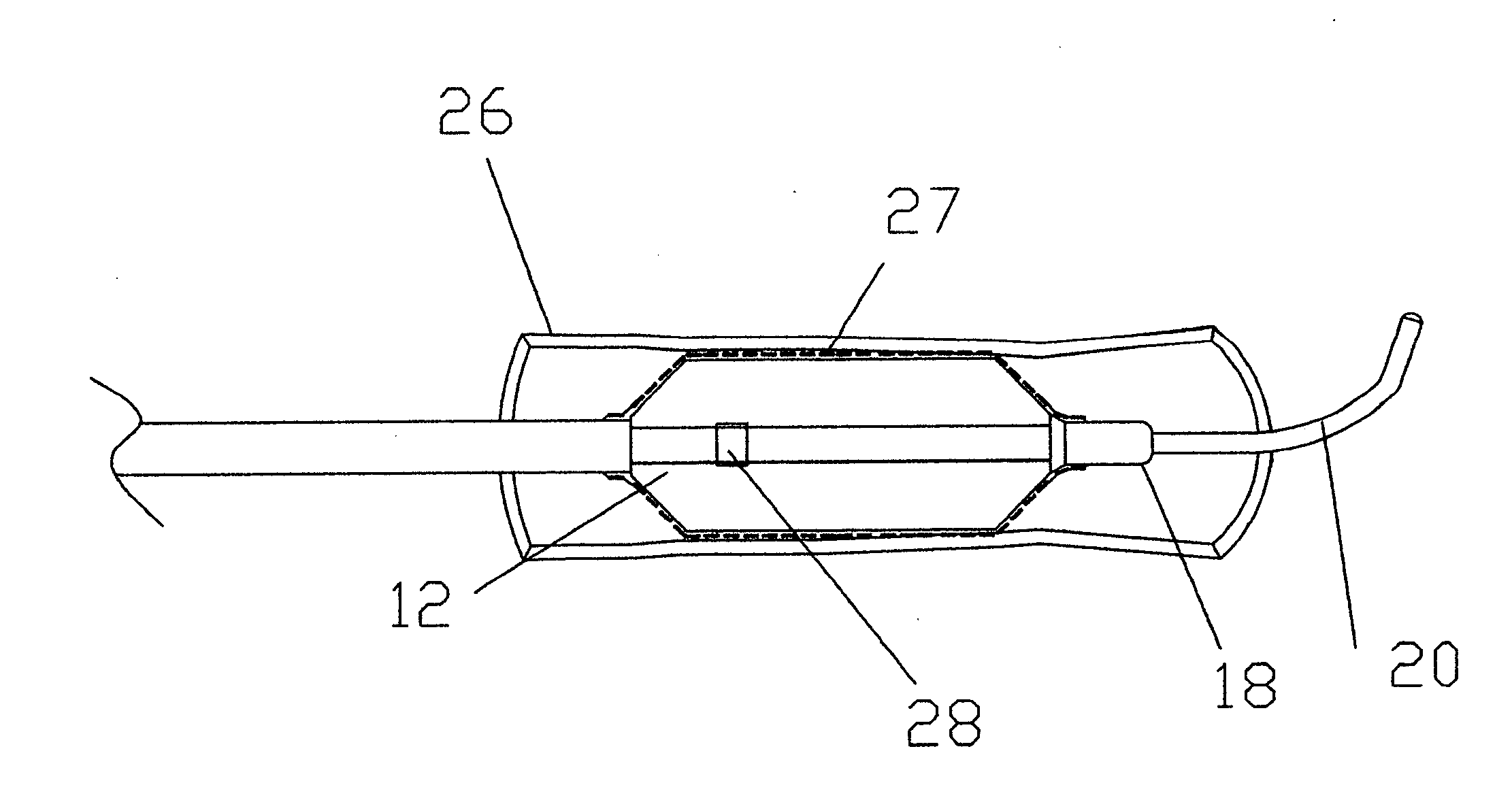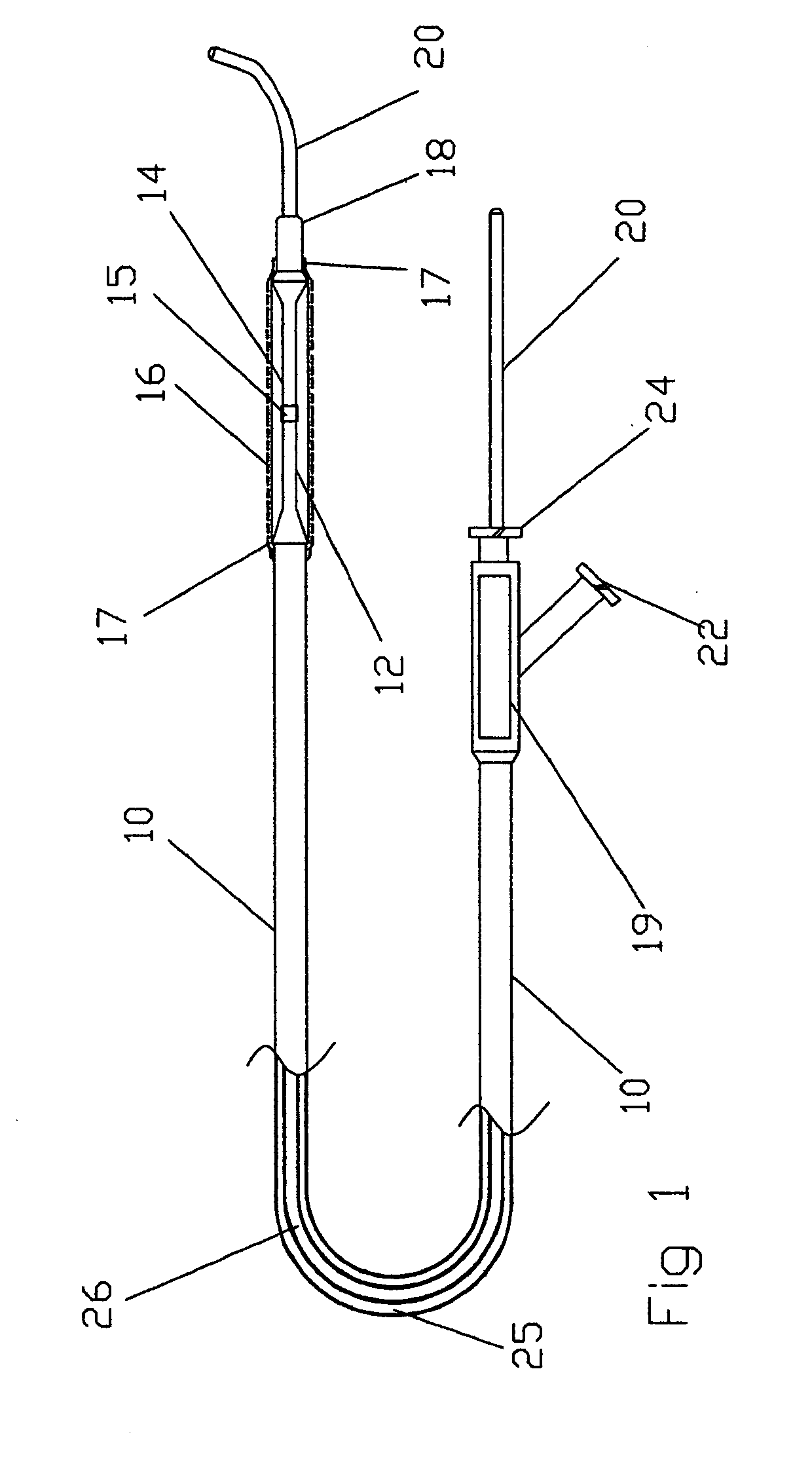[0043]The present invention describes the creation of a unique catheter, which will deliver therapeutic compounds to a localized area within the cardiovascular
system, such as
coronary arteries as well as other narrow conduits, or cavities of the body, such as arteries, the
bile duct, bronchi,
urethra,
ureter, heart, and bladder. Drugs or other therapeutic compounds will be forced through a vessel or tissue wall due to the inflation of a balloon and by maintenance of the drug containing porous member in contact with the
blood vessel wall for a period of time. To achieve this drug is carried on a thin distensible porous membrane that is affixed on to an expandable member such as a dilatation balloon. On expansion and in contact of the wall of the vessel therein the drug is forced out of the porous membrane into the wall of the vessel due to the pressure exerted by the balloon as well as due to contact of the drug carrying membrane with the
blood vessel wall. Additionally by using an
ultrasound or sub—
ultrasound vibration imparted using piezoelectric or similar methods on to the porous membrane, the penetration and transportation of the drug into the vessel wall therein can be enhanced. Additional drug may be provided by way of an additional lumen provided in the catheter for this purpose in situations where continuous supply of drug over a long period is necessary. The balloon will be chosen carefully so that the outer
diameter of the balloon and the porous membrane is such that there will be no over inflation of the blood vessel. The catheter can be designed to work as an over the wire (OTW) or rapid exchange (RX) catheter while accomplishing the same objective. In situations where blood flow distal to the balloon is required, such as in
coronary arteries, an additional lumen by passing the balloon is provided for this purpose. In most cases this lumen is also the guide wire lumen, whereby the guide wire is partially withdrawn to enable the flow of blood through the said lumen distally to the
lesion in the
artery. It is often necessary to re-advance the guide wire distal to the
lesion. And in other designs this is not possible or an additional lumen is provided for this purpose. In the present design a special feature is incorporated into this invention that will enable the operator to re-advance the guide wire after the drug therapy is completed in order to withdraw or relocate the catheter. This feature is not available in the other
perfusion catheters in the literature or in prior art. In an alternate arrangement to the present design an additional lumen can also be provided so that additional drug can be supplied into the porous membrane via this additional lumen. This feature will be useful when treating long lesions without having to remove the catheter to reload the porous membrane with the therapeutic drug.
[0044]The present device has many advantages over systemic or other
targeted drug delivery devices discussed earlier in that it (a) does not puncture the vessel or tissue wall, as is the case with catheters containing needles, and (b) it does not require
diffusion, which is a very slow process, as a means for drug absorption into the affected area, such as the case in drug coated balloons. The wall of a vessel could become damaged if it is punctured by needles or sharp protrusions causing additional injury resulting in
inflammation. Additionally,
drug delivery devices that use diffusion as the means to administer therapeutic agents into tissues are inefficient because the therapeutic agent may leak into the bloodstream and get washed away, or by the fact that only a small, insufficient amount of the drug successfully diffuses into the affected target area or lesion.
[0047]Another
advantage of the present device over the coated balloons and coated stents is that the user can chose the type of drug that is administered based on the lesion that is infused with the drug. Combination of drugs can also be used and in fact tandem treatment is also possible with the present invention, whereby one drug is infused first and the second drug is infused afterwards. As such, in this invention, unlike the coated balloon and coated
stent the user has the choice of the drug to be infused.
[0048]The present invention is very simple and easy to make, reducing the need for complicated production and handling procedures as in the case of catheters containing needles, catheters using heated fluids to restore predetermined shapes, such as coils, or catheters using coated balloon devices or coated
stent devices wherein the limited
drug coating may dissolve quickly or detach due to mechanical handling or can be readily washed away by the
blood stream.
[0050]The present device also incorporates a
perfusion lumen that will allow blood flow during this procedure so that the balloon can be in place inflated for a long period of time without having to
deflate due to any ischemic manifestations or discomfort to the patient. Additionally the ultrasonic energy and the non-ultrasonic energy enhance the process by which the drug is introduced into the vessel wall. The ultrasonic module can be within the balloon or can be attached to the proximal hub of the
balloon inflation lumen.
[0051]Thus, unlike many other drug delivery devices, the present invention delivers therapeutic compounds to its target without obstructing blood flow, or other biological processes, within the vessel or tissue. There is no limit to the amount of the drug or the
biological agent that can be injected as the porous membrane can absorb very large quantities of drug and the present invention also allows the operator to deliver varying quantities of the drug to different areas by properly positioning the porous membrane in the inflated balloon in those areas typically requiring more medication, so that more of the drug can be delivered to areas that require more treatment.
 Login to View More
Login to View More  Login to View More
Login to View More 


